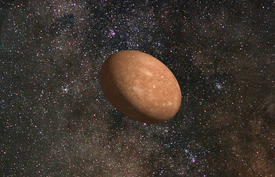(20000) Varuna
- See also Varuna (disambiguation).
(20000) Varuna is a classical Kuiper belt object, provisionally designated (2000 WR106), discovered on 28 November 2000 by the Spacewatch team from the Kitt Peak National Observatory (Arizona).
Not considered a planet, but a dwarf planet candidate. The International Astronomical Union has not classified it as such because the presence of hydrostatic equilibrium has not yet been demonstrated.
The name was suggested by Mrinalini Sarabhai. Varuna, in Hindu mythology, is the god of the sea, whose Greek equivalent is Poseidon and his Latin equivalent Neptune.
Its average diameter is estimated to be between 900 and 1060 km. It has an orbit outside that of Neptune, and is part of the so-called Kuiper belt. It is currently 6,000 million kilometers from Earth, and its orbit, although it remains to be determined exactly, is inclined about 20° with respect to that of our planet.
Discovery
Varuna was discovered following a series of follow-up observations by American astronomer Robert McMillan through the Spacewatch telescope on November 28, 2000. Varuna was identified as a slowly moving object in the sky through a blink microscope, comparing multiple images taken. Subsequently, astronomer Jeffrey Larsen continued to track the object by making multiple observations.
The formal announcement of the discovery was made on December 1 of the same year in a publication of the Minor Planet Center. At the time, Varuna was thought to be one of the largest and brightest minor planets in the solar system due to its relatively high apparent magnitude, which implied that it could be around a quarter of the size of Pluto and comparable in size to the planet. dwarf Ceres.
Orbit and rotation
Varuna orbits the Sun at an average distance of 42.7 AU and takes 279 years to complete its trajectory. Its orbit is nearly circular, with a low orbital eccentricity of 0.056. Due to its low orbital eccentricity, its distance from the Sun varies slightly over the course of its orbit. Varuna's orbit is inclined to the ecliptic by 17 degrees, similar to Pluto's orbital inclination. Varuna has reached its perihelion in 1928 and is currently moving away from the Sun, approaching its aphelion in 2071.
Varuna has a period of rapid rotation of approximately 6.34 hours, which was first measured in January 2001 by astronomer Tony Farnham using the McDonald Observatory 2.1-meter telescope as part of a study on the rotation of distant objects. It was revealed to show large variations in brightness with an amplitude of about 0.5 magnitudes. The measured rotational light curve provided two ambiguous rotation periods of 3.17 and 6.34 hours. Varuna's rapid rotation is thought to have been the result of disruptive collisions that accelerated its rotation during the formation of the solar system. The current collision rate in the trans-Neptunian region is minimal, although collisions were more frequent during the formation of the solar system.
Physical characteristics
In recent decades, observations have revealed the existence of numerous objects with an orbit higher than Neptune's. Scientists interested in revealing the surface of Kuiper belt objects such as (20000) Varuna (2000 WR106) have found that Varuna's estimated circular diameter is 900 (+125/-145) kilometers. Its albedo is estimated to be 0.070. Its surface is darker than Pluto's, suggesting an ice composition.
Varuna's shape is similar to a triaxial ellipsoid, and has resulted from its rapid rotation. Varuna's thermal emission has provided valuable information with which it has been possible to calculate the diameter of the object, although this has been difficult due to the limited observable wavelengths.
Possible satellite
The possible presence of an orbiting satellite is indicated based on photometric analyzes on the Varuna light curve. However, direct satellite observations of Varuna are unfeasible with current telescopes, since the angular distance between Varuna and the satellite is less than the resolution of current space telescopes.
Exploration
A flight mission to Varuna is estimated to take around twelve years using the gravity assists of the planet Jupiter and based on a launch date of 2035 or 2038. Alternative trajectories using gravity assists from Jupiter have also been considered, Saturn or Uranus. A trajectory using gravity assists from Jupiter and Uranus could take just over thirteen years, based on a launch date of 2034 or 2037, while a trajectory using gravity assists from Saturn and Uranus could take less than eighteen years, based on a launch date before 2025 or 2029. It is estimated that Varuna would be approximately 45 AU from the Sun when the spacecraft arrived before 2050, regardless of the trajectories used.
Contenido relacionado
Hubble–Lemaître law
Neil Armstrong
Stephen Hawking
